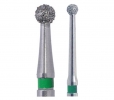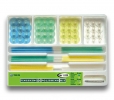BACKGROUND:
Insufficient residual alveolar bone height is a common deterrent in the placement of dental implants in the posterior maxilla. The use of autografts, xenografts, allografts and alloplasts or a combination between them has been demonstrated to be effective for increasing bone height and bone volume in the deficient posterior maxilla.
PURPOSE:
The aim of this clinical trial is to comparatively determine the density of newly formed in sinus floor augmentation bone after a 24-week healing period treatment with a new bovine xenograft.
MATERIALS AND METHODS:
The sinus floor was grafted with Bio-Oss® (n = 10) and Osseous® (n = 10). Histological sections were examined with a focus on the presence of connective tissue (CT) and newly formed bone (NFB). The sections were histomorphometrically evaluated and the definitive crown was inserted after 3 months.
RESULTS:
After 6 months, the mean value of new bone formation was 24.60 (±2.503), the CT was 42.60 (±4.006) and the remaining biomaterial was 25.40 (±2.547) in Bio-Oss group. In Osseous group, the mean value of new bone formation was 24.90 (±3.542), the CT was 45.70 (±7.040) and the remaining biomaterial was 22.90 (±3.247).
CONCLUSIONS:
Both biomaterials afforded a favorable implant position and the prosthetic rehabilitation.
Source: 25535980 [PubMed - in process]
Publication date: 2015 Oct;17




